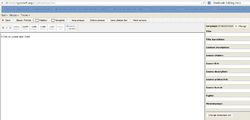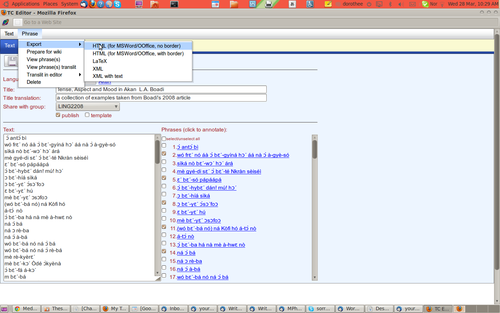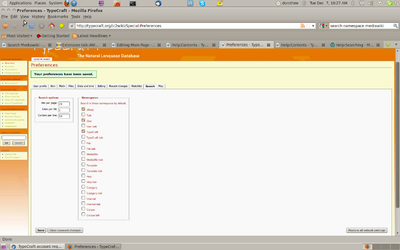Difference between revisions of "Help:QuickStart"
(→Help with the TC Editors) |
(→The tabular annotation edit) |
||
| Line 58: | Line 58: | ||
''' To learn more about the tiers and the type of annotation you can add go to''' | ''' To learn more about the tiers and the type of annotation you can add go to''' | ||
| + | '''[[Multi-level linguistic annotation with TypeCraft]]''' | ||
The *WORD* and the *MORPH* tier feature a menu bar which allows you to delete words/morphs which appear when you click on the field in tphose rows that you would like to change. From the menu you can also add words or change the word segmentation. *Gloss* and *POS* tags are chosen from a predefined list. You find an overview over all Gloss and POS tags on your navigation bar. These lists are auto-generated and can be ordered by category at your convenience. | The *WORD* and the *MORPH* tier feature a menu bar which allows you to delete words/morphs which appear when you click on the field in tphose rows that you would like to change. From the menu you can also add words or change the word segmentation. *Gloss* and *POS* tags are chosen from a predefined list. You find an overview over all Gloss and POS tags on your navigation bar. These lists are auto-generated and can be ordered by category at your convenience. | ||
| − | |||
===Annotation using the TypeCraft 1.0 editor=== | ===Annotation using the TypeCraft 1.0 editor=== | ||
Revision as of 11:02, 25 September 2014
|
|
This page is currently under development.Thank you for your patience. |
Contents
- 1 This is the TypeCraft QuickStart Guide
- 1.1 Help with the TC Editors
- 1.2 Help with the TCwiki
- 1.2.1 How to start a TCwiki-page
- 1.2.2 Help with editing in the TC wiki
- 1.2.3 How to find things in the TC wiki
- 1.2.4 How to write an e-mail to another TypeCraft user
- 1.2.5 Upload a file
- 1.2.6 How to embed audio files in already existing pages
- 1.2.7 How to edit the title of an already exiting article
This is the TypeCraft QuickStart Guide
For more information about linguistic online editing with TypeCraft, search in the TypeCraft database, exporting TypeCraft data, or editing the TypeCraft wiki, please consult one of the following TypeCraft wiki pages:
- Help with the TypeCraft Editor for Newcomers
- Help with the using the TypeCraft Editor
- Help with posting on the TypeCraft Wiki
- Help with Search in Typecraft data
- Help with Editing the TypeCraft wiki
Help with the TC Editors
Annotation using the TypeCraft 2.0 editor
You enter the TC2 editor by clicking on New text one the TypeCraft navigation bar. The editor opens a dialog window with the following message:
Your text will use the new and better TC editor. If for some reason you want to use the old editor choose No below.
The word "Text" in phrase "Your text" above refers to any piece of digital writing not yet linguisticaly annotated. To annotate this text in the new editor, you now press "yes"
The editor's text area opens (see screenshot to the left). To the right the Metadata matrix is accessible. We offer a default Metadata template and a template for the Norwegian Centre for Writing and Writing Research. (You find a *Change Metadata set* bottom at the end of the template.)
You enter your text into the text area by copying & pasting text from a file or from an online site into the text area. Next you select the text' lanuage in the metadata template and provide the rest of the metadata. You always can come back to this, and fill in missing information.
Back to the text area you now define what we call Phrases for annotation. TypeCraft phrases might be sentences or fragments. Also, text does not need to be annotated sentence by sentence, although that is also possible by .............. ............... .
You select an element for annotation by highlighting it. You then press the New Phrase button which will put the selected element into the Phrase list. In the text area this phrase now appears in green.
Now it is time for starting with the core annotation. You can do that in two ways. You double-click on one of the instantiated elements in the text area (those sentence in green colour), or you open the Phrase list by clicking on *View Phrase list*.
When the phrase opens a dialog window pops-up with the following message:
TypeCraft wants to know which of the following options you prefer: 1. to insert full forms into the table directly (recommended). Choosing this option allows you to separate affixes from word stems in the input mask below. In order to do so insert hyphens "-" or spaces " " to indicate morpheme or word boundaries and then click OK. 2. to insert words from your phrase manually into the table. Click Cancel and an empty table will appear.
The tabular annotation edit
After you have decided whether you would like to work with a prefilled table which realises your choice of morpheme boundaries, or if you would like to start with a clean table, the tabluar editor will open with a prefilled or empty table.
You annotate by navigating through the table. We recommand that you add annotations to the tiers vertically by making use of the space bar. This method is in our experience the fastest.
To learn more about the tiers and the type of annotation you can add go to
Multi-level linguistic annotation with TypeCraft
The *WORD* and the *MORPH* tier feature a menu bar which allows you to delete words/morphs which appear when you click on the field in tphose rows that you would like to change. From the menu you can also add words or change the word segmentation. *Gloss* and *POS* tags are chosen from a predefined list. You find an overview over all Gloss and POS tags on your navigation bar. These lists are auto-generated and can be ordered by category at your convenience.
Annotation using the TypeCraft 1.0 editor
Click *My Text* in the navigation-bar. The TC Editor opens. You may now enter or copy-and-paste a text into the left part of the editor window. Do not add morph boundaries at this point. At this point the TC Editor only accepts text strings. Before you start to tokenize your text strings, determine the language of your text by going to the *CHANGE* button. TC uses the ISO-639-1 code for languages. Please use the drop-down window to select one of the ISO language namYour text will use the new and better TC editor.
If for some reason you want to use the old editor choose No below.s. Give your text a title and a title translation if appropriate. Text title and title translation will inform *Text search* and therefore should be chosen with care.
Tokenization You can tokenise your text into sentences. This generally works quite well. TypeCraft has at this point still problems with period signs for example in titles like Mr. or Dr. and semicolons. In order to tokenise you text or collection of sentences press *CREATE PHRASES*; this will initiate the tokenization. Inspect the result before you choose *Yes* from the dialogue box. If you have not highlighted parts of your text, TC will ask you whether you would like to tokenize the whole text. Say *Yes*. The tokenization can be repeated several times until you are content with the result.
Morph break-up Select a sentence from the set of tokenised sentences which now have appeared on the right hand side of your editor window. Click on one sentence. This will open a dialogue box. Follow the instructions in the dialogue box to insert morph boundaries into the annotation table.
Annotation Table Navigate through the annotation levels vertically by making use of the space bar. The *WORD* and the *MORPH* tier feature a menu bar which allows you to delete words/morphs which appear when you click on the field in those rows that you would like to change. From the menu you can also add words or change the word segmentation. *Gloss* and *POS* tags are chosen from a predefined list. You find an overview over all Gloss and POS tags on your navigation bar. These lists are auto-generated and can be ordered by category at your convenience.
Export
The TypeCraft user-interface allows for several forms of export:
- Export to the TCwiki
- Export to HTML
- Export to WORD and Open Office
In your TypeCraft Editor go to the tab *Phrase* in the upper left corner of your editor window. When pressing on *Phrase* a drop-down window opens. Select the first option which is: *Export*.
Export to the TCwiki
For a description of the export to the TCwiki, please follow this link: Export to the TC wiki.
Export to WORD and Open Office
The export to WORD or Open Office is done through several simple steps: Go to the TypeCraft Editor by opening *My texts*. You select one of your texts and open it. This can look for example like this:
As shown in the picture on the left, you can now select the sentences that you would like to export by marking them in the check boxes on the left of the instantiated sentences (the blue sentences to the right of the Editor window). Go to the tool tabs of the Editor window and select Phrases -> Export -> HTML (just as it is shown in the picture). You have the choice of exporting the examples with or without border. Make your choice and save the Tc-export file to your computer. (You will see a small pop-up window that asks you to either open or save the Tc-export file. You should save the file.) When you now open the exported file on your machine, the default option that you will be presented with is to open the file in your browser (for example Firefox,Chrome, IE or Safari). In order to save the Tc-export file as a WORD or Open Office document you have to open the file by choosing the option *Open with* -> WORD or Open Office. Notice that the imported examples can still be manipulated. For example you might want to change the font size or highlight certain glosses, add colour or borders.
This is a feature of your TypeCraft editor that must be set by the system administrator. In your mail to the administrator, please state which name you wish for your group (for example the name of your project or the name of the language you work on), and the TypeCraft user names of all members of the group that you would like to start. The system administrator will create the group for you. This will not take very long, and when the group is created, you can start to assign texts to your group, by selecting in your TypeCraft Editor from the *Share with group* line your group.
Help with the TCwiki
How to start a TCwiki-page
There several ways to start a new page in the TCwiki:
- Write the name of the page you want to create into the search-box on your navigation bar. You write for example: Noun Phrases in Luganda. Then press *GO*. A special page opens for you. It mentions Search Results. If there does not yet exist a page with the title you choose for the page you are about to create, the search result is empty, and it says:"There is no page titled "Noun Phrases in Luganda. You now can create your page." That means that nobody else on the TCwiki has written about Noun Phrases in Luganda using the same title as you plan to use. The text: "You can create this page" is a link. Press this link. A new page appears with the title: Editing Noun Phrases in Luganda. On top of this page you see a tool-bar. Go there and press the button *CREATE*. You now have created that page and can start to edit it.
- Another way to create a new page is to start that page from your homepage at TC. You go to your homepage by pressing on your name in the upper right corner of your browser window. Remember you must be logged in to edit the TCwiki. On your homepage you go to the tool-bar above your page and press the *EDIT* button. You see a white field with the text and other material that you have put on your homepage. Go to the tool-bar right above your edit-box. The third button from the left is the button that creates an internal link for you. Press that button. The following code will be appear in your edit box: [[Link title]]. Replace the text Link title by the name of the page that you would like to create; so Noun Phrases in Luganda. Save your page and press the internal link that you just created. Again you come to a page called 'Editing Noun Phrases in Luganda', and again you want to go to the top of that page and press the button *CREATE*. You now have created that page and can start to edit it. Notice also that this new page in now linked to your homepage.
Help with editing in the TC wiki
The TCwiki is a customised mediawiki. Mediawiki has published a series of good Editing User's Guide that you can access by following the links below.
A quick reference guide can be found here: Reference Sheet (You can enlarge the reference sheet by clicking on it!)
- General editing help for beginners can be found here: User's Guide
- How to integrate pictures into your wiki page is explained here: Picture tutorial
- How to edit tables can be found here: Tables tutorial
- How to integrate a google map into your page is explained here: ...more follows...
How to find things in the TC wiki
The easiest way to find things on the TCwiki is to use the search window on the navigation bar. Type for example *annotation* and click *GO*. You will get up many pages containing the word (A,a)nnotat... in the page title.
THe scope of you search depends on in which namespace you search. For the search in the TCwiki it might be best to search in the following four namespaces:
- Main
- User
- TypeCraft
- Category
- Classroom
You customise your search by going to *my preference* in the right upper corner of your browser window. Select my preferences -> User profile -> *SEARCH*. Select the relevant namespaces by ticking of boxes. Save your preferences.
How to write an e-mail to another TypeCraft user
Many TypeCraft users have enabled a function called enable e-mail from other users. If you have not done that yet, you can go so by going to *my preferences* which you find in the left upper corner of your browser, next to your name. When in *my preferences* scroll down to the section E-mail.
In order to mail other users, go to the user's homepage. You find home pages by searching for the user's name. A list of users that have entered data into the TypeCraft database can be found at TypeCraft contributors.
Upload a file
- Prepare the file for upload.
- In the sidebar, under “tools”, click “Upload file.”
- Click “Browse” next to the “Source filename:” to locate the file on your computer (the name of the “browse” button depends on your web browser).
- Change the “Destination filename:” to something descriptive, if necessary.
- Fill in the “Summary”, if necessary.
- Click the “Upload file” button.
If it is a large file, you may need to wait several seconds for the upload to complete.
The file has been loaded to the Gallery of new files under Special Pages.
Embed a file in your TCwiki page
To embed your loaded file in a TCwiki page, you have to specify its file name inside of an internal link ([[ ]]). Thus, [[Media:test.pdf]] for example makes it possible to download the PDF document with the name test from your
TCwiki page.
How to embed audio files in already existing pages
You can play TyepCraft internal mp3 audiofiles by embedding the mp3 file into a TC wiki page. You use the following notation: <flashmp3>YOUR_FILE_NAME.mp3</flashmp3>.
You choose edit for the page into which you would like to embed the audio, and embed the <flashmp3>YOUR_FILE_NAME.mp3</flashmp3> string at the place where the audio should appear.
How to edit the title of an already exiting article
You can change the title of your article my using the Move tab at the top of your wiki-page. When you press the tab a new window appears. The picture of such a page which you see to the right shows how to rename (=move) a page.
In the field with the name: To new title: you fill in the new title of your page. You may also fill in a reason for renaming your page in the field below, but that is not obligatory. Press the Move button and you will come to a new screen which tells you that the page has now been 'moved' to the new title. The new title at this page is a link to your page. Pressing this link will bring you again to your page which now carries its new title.



